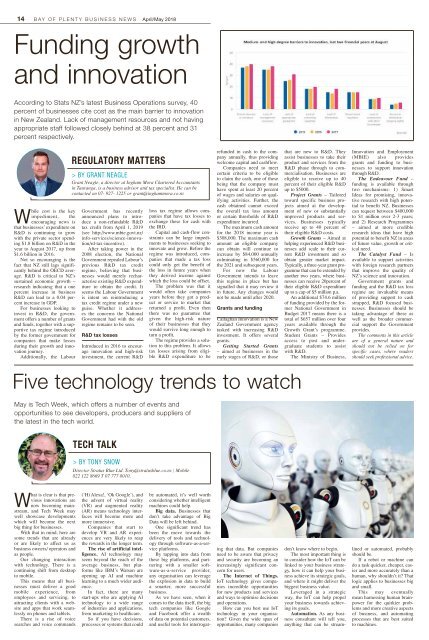Bay of Plenty Business News April/May 2018
From mid-2016 Bay of Plenty businesses have a new voice, Bay of Plenty Business News. This new publication reflects the region’s growth and importance as part of the wider central North Island economy.
From mid-2016 Bay of Plenty businesses have a new voice, Bay of Plenty Business News. This new publication reflects the region’s growth and importance as part of the wider central North Island economy.
- No tags were found...
You also want an ePaper? Increase the reach of your titles
YUMPU automatically turns print PDFs into web optimized ePapers that Google loves.
14 BAY OF PLENTY BUSINESS NEWS <strong>April</strong>/<strong>May</strong> <strong>2018</strong><br />
Funding growth<br />
and innovation<br />
According to Stats NZ’s latest <strong>Business</strong> Operations survey, 40<br />
percent <strong>of</strong> businesses cite cost as the main barrier to innovation<br />
in New Zealand. Lack <strong>of</strong> management resources and not having<br />
appropriate staff followed closely behind at 38 percent and 31<br />
percent respectively.<br />
While cost is the key<br />
impediment, the<br />
encouraging news is<br />
that businesses’ expenditure on<br />
R&D is continuing to grow<br />
with the private sector spending<br />
$1.8 billion on R&D in the<br />
year to August 2017, up from<br />
$1.6 billion in 2016.<br />
Not so encouraging is the<br />
fact that NZ still lags significantly<br />
behind the OECD average.<br />
R&D is critical to NZ’s<br />
sustained economic growth –<br />
research indicatesg that a one<br />
percent increase in business<br />
R&D can lead to a 0.04 percent<br />
increase in GDP.<br />
For businesses looking to<br />
invest in R&D, the government<br />
<strong>of</strong>fers a number <strong>of</strong> grants<br />
and funds, together with a supportive<br />
tax regime introduced<br />
by the former government for<br />
companies that make losses<br />
during their growth and innovation<br />
journey.<br />
Additionally, the Labour<br />
REGULATORY MATTERS<br />
> BY GRANT NEAGLE<br />
Grant Neagle, a director at Ingham Mora Chartered Accountants<br />
in Tauranga, is a business advisor and tax specialist. He can be<br />
contacted on 07- 927- 1225 or grant@inghammora.co.nz<br />
Government has recently<br />
announced plans to introduce<br />
a non-refundable R&D<br />
tax credit from <strong>April</strong> 1, 2019<br />
(see http://www.mbie.govt.nz/<br />
info-services/science-innovation/rd-tax-incentive).<br />
After taking power in the<br />
2008 election, the National<br />
Government repealed Labour’s<br />
previous R&D tax credit<br />
regime, believing that businesses<br />
would merely recharacterise<br />
existing R&D expenditure<br />
to obtain the credit. It<br />
seems the Labour Government<br />
is intent on reintroducing a<br />
tax credit regime under a new<br />
guise. Whether it addresses<br />
the concerns the National<br />
Government had with the old<br />
regime remains to be seen.<br />
R&D tax losses<br />
Introduced in 2016 to encourage<br />
innovation and high-risk<br />
investment, the current R&D<br />
loss tax regime allows companies<br />
that have tax losses to<br />
exchange these for cash with<br />
the IRD.<br />
Capital and cash-flow constraints<br />
can be large impediments<br />
to businesses seeking to<br />
innovate and grow. Before the<br />
regime was introduced, companies<br />
that made a tax loss<br />
could only get the benefit <strong>of</strong><br />
the loss in future years when<br />
they derived income against<br />
which the loss could be <strong>of</strong>fset.<br />
The problem was that it<br />
would <strong>of</strong>ten take companies<br />
years before they got a product<br />
or service to market that<br />
returned a pr<strong>of</strong>it. Even then<br />
there was no guarantee that<br />
given the high-risk nature<br />
<strong>of</strong> their businesses that they<br />
would survive long enough to<br />
turn a pr<strong>of</strong>it.<br />
The regime provides a solution<br />
to this problem. It allows<br />
tax losses arising from eligible<br />
R&D expenditure to be<br />
refunded in cash to the company<br />
annually, thus providing<br />
welcome capital and cashflow.<br />
Companies need to meet<br />
certain criteria to be eligible<br />
to claim the cash, one <strong>of</strong> these<br />
being that the company must<br />
have spent at least 20 percent<br />
<strong>of</strong> wages and salaries on qualifying<br />
activities. Further, the<br />
cash obtained cannot exceed<br />
the overall tax loss amount<br />
or certain thresholds <strong>of</strong> R&D<br />
expenditure incurred.<br />
The maximum cash amount<br />
for the <strong>2018</strong> income year is<br />
$308,000. The maximum cash<br />
amount an eligible company<br />
can obtain will continue to<br />
increase by $84,000 annually<br />
culminating in $560,000 for<br />
the 2021 and subsequent years.<br />
For now the Labour<br />
Government intends to leave<br />
this regime in place but has<br />
signalled that it may review it<br />
in future. Any changes would<br />
not be made until after 2020.<br />
Grants and funding<br />
Callaghan Innovation is a New<br />
Zealand Government agency<br />
tasked with increasing R&D<br />
investment. It <strong>of</strong>fers several<br />
grants.<br />
Getting Started Grants<br />
– aimed at businesses in the<br />
early stages <strong>of</strong> R&D, or those<br />
that are new to R&D. They<br />
assist businesses to take their<br />
product and services from the<br />
R&D phase through to commercialisation.<br />
<strong>Business</strong>es are<br />
eligible to receive up to 40<br />
percent <strong>of</strong> their eligible R&D<br />
up to $5000.<br />
Project Grants – Tailored<br />
toward specific business projects<br />
aimed at the development<br />
<strong>of</strong> new or substantially<br />
improved products and services.<br />
<strong>Business</strong>es typically<br />
receive up to 40 percent <strong>of</strong><br />
their eligible R&D costs.<br />
Growth Grants – Aimed at<br />
helping experienced R&D businesses<br />
add scale to their current<br />
R&D investment and so<br />
obtain greater market impact.<br />
Typically, a three-year grant programme<br />
that can be extended by<br />
another two years, where businesses<br />
can receive 20percent <strong>of</strong><br />
their eligible R&D expenditure<br />
up to a cap <strong>of</strong> $5 million p.a.<br />
An additional $74.6 million<br />
<strong>of</strong> funding provided by the former<br />
National Government in<br />
Budget 2017 means there is a<br />
total <strong>of</strong> $657 million over four<br />
years available through the<br />
Growth Grant’s programme.<br />
Student Grants – Provides<br />
access to post and undergraduate<br />
students to assist<br />
with R&D.<br />
The Ministry <strong>of</strong> <strong>Business</strong>,<br />
Innovation and Employment<br />
(MBIE) also provides<br />
grants and funding to businesses<br />
to support innovation<br />
through R&D.<br />
The Endeavour Fund –<br />
funding is available through<br />
two mechanisms: 1) Smart<br />
Ideas for promising, innovative<br />
research with high potential<br />
to benefit NZ. <strong>Business</strong>es<br />
can request between $400,000<br />
to $1 million over 2-3 years;<br />
and 2) Research Programmes<br />
– aimed at more credible<br />
research ideas that have high<br />
potential to benefit NZ in areas<br />
<strong>of</strong> future value, growth or critical<br />
need.<br />
The Catalyst Fund – Is<br />
available to support activities<br />
with foreign research partners<br />
that improve the quality <strong>of</strong><br />
NZ’s science and innovation.<br />
Government grants and<br />
funding and the R&D tax loss<br />
regime are invaluable means<br />
<strong>of</strong> providing support to cash<br />
strapped, R&D focused businesses.<br />
<strong>Business</strong>es should be<br />
taking advantage <strong>of</strong> these as<br />
well as the broader commercial<br />
support the Government<br />
provides.<br />
The comments in this article<br />
are <strong>of</strong> a general nature and<br />
should not be relied on for<br />
specific cases, where readers<br />
should seek pr<strong>of</strong>essional advice.<br />
Five technology trends to watch<br />
<strong>May</strong> is Tech Week, which <strong>of</strong>fers a number <strong>of</strong> events and<br />
opportunities to see developers, producers and suppliers <strong>of</strong><br />
the latest in the tech world.<br />
TECH TALK<br />
> BY TONY SNOW<br />
Director Stratus Blue Ltd. Tony@stratusblue.co.nz | Mobile<br />
022 122 8669 T 07 777 0010.<br />
What is clear is that previous<br />
innovations are<br />
now becoming mainstream,<br />
and Tech Week may<br />
well showcase developments<br />
which will become the next<br />
big thing for businesses.<br />
With that in mind, here are<br />
some trends that are already<br />
or are likely to affect us as<br />
business owners/ operators and<br />
as people.<br />
Our changing interaction<br />
with technology. There is a<br />
continuing shift from desktop<br />
to mobile.<br />
This means that all businesses<br />
must deliver a good<br />
mobile experience, from<br />
employees and servicing, to<br />
attracting clients with a website<br />
and apps that work seamlessly<br />
on phones and tablets.<br />
There is a rise <strong>of</strong> voice<br />
searches and voice commands<br />
(‘Hi Alexa!, ‘Ok Google’), and<br />
the advent <strong>of</strong> virtual reality<br />
(VR) and augmented reality<br />
(AR) means technology interfaces<br />
will become more and<br />
more immersive.<br />
Companies that start to<br />
develop VR and AR experiences<br />
are very likely to reap<br />
the rewards in the longer term.<br />
The rise <strong>of</strong> artificial intelligence.<br />
AI technology may<br />
seem beyond the reach <strong>of</strong> the<br />
average business, but platforms<br />
like IBM’s Watson are<br />
opening up AI and machine<br />
learning to a much wider audience.<br />
In fact, there are many<br />
start-ups who are applying AI<br />
technology to a wide range<br />
<strong>of</strong> industries and applications,<br />
from marketing to healthcare.<br />
So if you have decisions,<br />
processes or systems that could<br />
be automated, it’s well worth<br />
considering whether intelligent<br />
machines could help.<br />
Big data. <strong>Business</strong>es that<br />
don’t take advantage <strong>of</strong> Big<br />
Data will be left behind.<br />
One significant trend has<br />
been the move towards the<br />
delivery <strong>of</strong> tools and technology<br />
through s<strong>of</strong>tware-as-a-service<br />
platforms.<br />
By tapping into data from<br />
these big platforms, and partnering<br />
with a smaller s<strong>of</strong>tware-as-a-service<br />
provider,<br />
any organisation can leverage<br />
the explosion in data to build<br />
a smarter, more successful<br />
business.<br />
As we have seen, when it<br />
comes to the data itself, the big<br />
tech companies like Google<br />
and Facebook <strong>of</strong>fer a wealth<br />
<strong>of</strong> data on potential customers,<br />
and useful tools for interrogating<br />
that data. But companies<br />
need to be aware that privacy<br />
and security are becoming an<br />
increasingly significant concern<br />
for users.<br />
The Internet <strong>of</strong> Things.<br />
IoT technology gives companies<br />
incredible opportunities<br />
for new products and services<br />
and ways to optimise decisions<br />
and operations.<br />
How can you best use IoT<br />
technology in your organisation?<br />
Given the wide span <strong>of</strong><br />
opportunities, many companies<br />
don’t know where to begin.<br />
The most important thing is<br />
to consider how the IoT can be<br />
linked to your business strategy,<br />
how it can help your business<br />
achieve its strategic goals,<br />
and where it might deliver the<br />
biggest business value.<br />
Leveraged in a strategic<br />
way, the IoT can help propel<br />
your business towards achieving<br />
its goals.<br />
Automation. As any business<br />
consultant will tell you,<br />
anything that can be streamlined<br />
or automated, probably<br />
should be.<br />
If a robot or machine can<br />
do a task quicker, cheaper, easier<br />
and more accurately than a<br />
human, why shouldn’t it? That<br />
logic applies to businesses big<br />
and small.<br />
This may eventually<br />
mean harnessing human brainpower<br />
for the quirkier problems<br />
and more creative aspects<br />
<strong>of</strong> business, and automating<br />
processes that are best suited<br />
to machines.


















